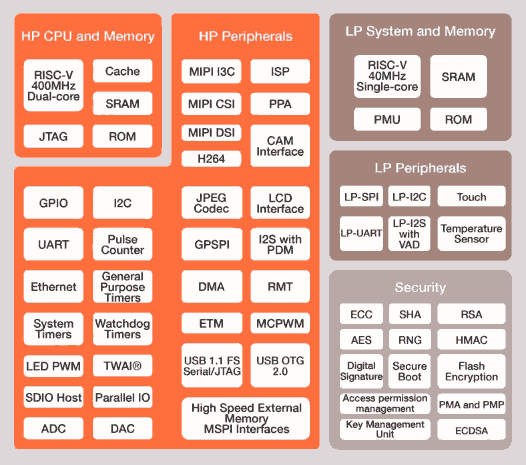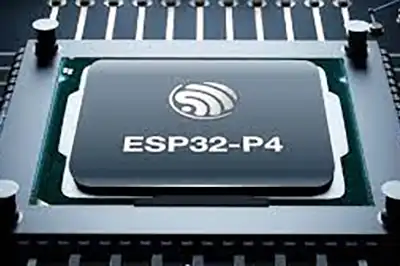The ESP32-P4 is a system on chip (SoC) developed by Espressif Systems that stands out for its enormous power, number of connections, and security features.
This powerful SoC is powered by a dual-core RISC-V processor up to 400MHz which also features floating-point extensions (FPU) and artificial intelligence (AI).
In addition, the ESP32-P4 incorporates an LP (low power) core at 40Mhz. This processor is used in low power consumption applications, while the HP cores are reserved for tasks requiring high computing power.
That is, we have an extremely powerful processor for what is usually common in embedded processors and IoT. Which, in addition, also allows operation in scenarios where energy efficiency is vital.
In terms of memory, the ESP32-P4 integrates 768KB of SRAM on the chip with the possibility of adding more PSRAM memory externally. It also has 8KB of zero-wait RAM TCM, which can be used as a high-speed buffer.

In terms of connections, the ESP32-P4 is a monster with more than 50 programmable GPIO. It supports all commonly used peripherals, such as SPI, I2S, I2C, LED PWM, MCPWM, RMT, ADC, DAC, UART, and TWAITM.
The ESP32-P4 also has support for high-speed connectivity via USB OTG 2.0 HS, Ethernet, and SDIO Host 3.0, and support for MIPI-CSI and MIPI-DSI for connecting displays or cameras.
It also includes capacitive touch inputs, voice recognition functions, even support for H.264 video encoding, and PPA (Pixel Processing Accelerator) acceleration for GUI development. Basically, this thing has it all 😮.
In terms of security features, as we mentioned earlier, it is one of the points that Espressif focuses on for the design of the ESP32-P4. This SoC has advanced security features such as Secure Boot, Flash encryption, cryptographic accelerators, TRNG, Digital Signature Peripheral, and Key Management Unit.
As a negative point, unlike most members of the ESP32 range, the ESP32-P4 lacks wireless connectivity. Instead, the manufacturer recommends connecting it with another ESP32-C/S/H series chip via SPI/SDIO/UART.
As we can see, the ESP32-P4 is a top-notch processor mainly aimed at Edge Computing and AI applications in IoT. It is an extremely powerful SoC that is also suitable for low-energy applications.
The lack of wireless connectivity takes away several points. But, I suppose, as devices and boards that use it appear, it will be common to see it in a Dual configuration with another ESP32 (we’ll have to see how it turns out).
References:
